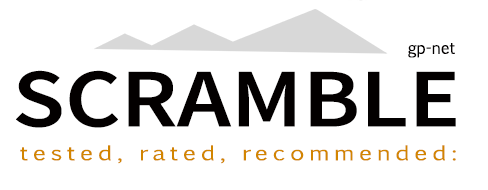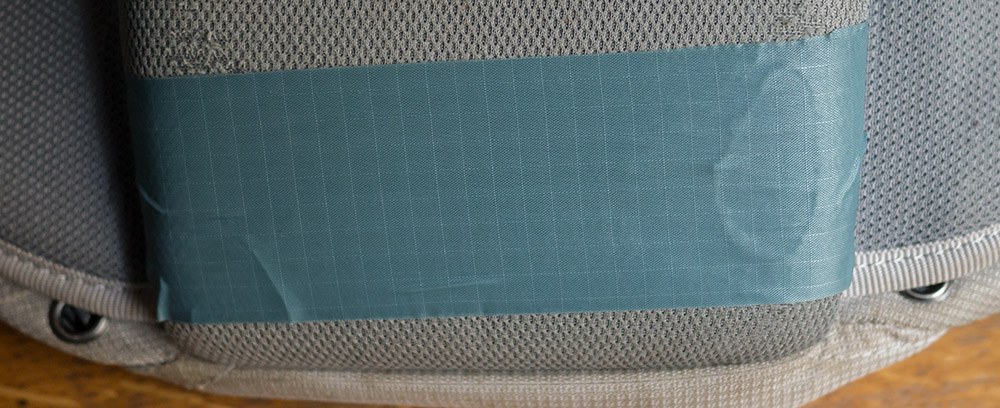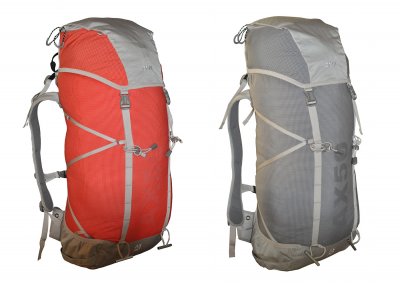Crux's AX50 Climbing Pack (50L)
Preface
This Crux AX50 review was a "special mention", but now the Blue Ice Warthog 40 (pre-2019) is impossible to track down, the equally capable AX50 takes the top spot.
As always, we're looking at the Crux AX50 from the point of view of long distance trekking over tough terrain.
Test subject: Chest 42", Waist 33", Height: 5ft 8"
Test item: Back length = Regular, Colour = "Smoke"
Kit Tests: Multiple
Disclaimer: None required (item not provided by manufacturer)
Datasheet
| Main Material: Dyneema / Cordura (150 g/sm) | 15% / 85% |
| Base & Reinforcement Material: 420D high density riptop nylon (layered over main material for base panel) | 100% |
| Treatments: DWR finish | - |
| Capacity (reduced / native / extendable): | 40L / 50L / ~60L |
| Weight (non-stripped weights): | 1180g |
| Manufacturer RRP | £179.00 |
Scramble Review
Contents
- Introduction: The Crux Of The Biscuit
- The AX50: Capacity, Configuration
- Materials & Features
- Any Negatives?
- Conclusion, Rating & Product Images
Introduction: The Crux Of The Biscuit
Who Are Crux?
Crux are a small UK-based mountaineering brand founded by New Zealand alpinist Carol McDermott. What's so refreshing about Crux is their steadfast commitment to making high quality equipment and apparel specifically for mountaineers and climbers. One gets the impression that design and material choices absolutely supersede some accounting price-point or market segment targeting.
What this means is that Crux (somewhat like Scramble) are designing gear for people like them, and the design focus is on (the passion) "what would we want" rather than (the corporate) "what will our customers accept" (where profit motives dominate and PR and marketing departments bridge the shortfall). In short, we admire, and find refreshing, Crux's approach and ethic.
What Do We Want in a Mountain Trekking Pack?
We've decided to tighten up our criteria for what we demand from a distance trekking mountain pack. In summer we regularly carry a minimum of 10 day's food supplies and in winter, 7 days (where additional equipment and larger sleeping bags are required). Thus a single pack must be extensible (allow some degree of modularity) and have a minimum 40L native capacity with the ability to extend to 60L.
In addition the pack must be able to accommodate a belt bag setup or harness and thus large padded hip-belts (i.e. "touring packs") are out. Further we want our packs to have a high centre of gravity and to handle well when climbing / scrambling. The pack should be as tough and durable as possible and yet competitively lightweight.
These criteria generally push us toward minimalist climbing packs, as (something we share with mountaineers) between point A and point B there's only a select number of items we may need access to and these can be housed in supplemental carry options such as Scramble's 11L Towers.
So, in essence we want a tough yet light, 40L to 60L climbing pack. Our prior recommendation, the Blue Ice Warthog 40 fitted the bill, but Blue Ice have strayed from their "Cruxian" roots and the latest incarnations of their Warthogs are frail (they would say ultralight, no doubt cheaper to manufacture) imitations of their (now rare) original designs.
The AX50 and the older Warthog 40 models have a good deal in common, but there are substantial differences, and the Crux AX50 has both pros and cons when stacked against the Warthog. So, now the old Warthog is officially dead, the Crux AX50, which was very much the heir in waiting, is our top choice Let's see why ...
The AX50: Capacity, Configuration
There's a bit more going on with the Crux AX50 compared to the simpler Warthog. Though it has a larger native 50L capacity the Crux can be extended both ways: it can be stripped down to carry less and extended to carry more. Many of its elements are removable to make a lighter less capacious pack for shorter treks:
- The "floating lid" can be removed
- The internal titanium stays (that bend to fit the back and provide stability) can be removed
- The Z-compression straps and sternum strap can be removed
- The hip belt padding can be removed
Removing all this will give you a 40L pack well under a kilo in weight.
One of the things we like about the AX50 is how well it maintains its shape and stability throughout the course of a trek. Pictured below (left) is the pack fully loaded with approx. 25L of food supplies and then at the back-end of the trek (right) with just a few days of supplies remaining.
 The Crux AX50 maintains its form as supplies dwindle.
The Crux AX50 maintains its form as supplies dwindle.
You'll notice the AX50 supports only a single 11L Tower in the "T" configuration due to its Z-compression straps (pictured below left, a Tower is best suited under the lid or attached to the front face, not on the sides).
The Crux AX50 has a larger native 50L capacity than Blue Ice's Warthog 40. However, the Warthog features traditional compression / side straps which enable it to carry a Tower on either side. On the AX50 the lighter Z-compression straps that zig-zag their way up the sides of the pack are just that and they won't support afixing heavy bulk, though they are useful for fixing less bulky items such as skis, climbing tools, and in my case a green waste-bin stuff sack to the side of the pack (pictured below right).
 The AX50's Z-compression straps, back panel and removeable hip belt.
The AX50's Z-compression straps, back panel and removeable hip belt.
So the Crux AX50 can go down 10L (to 40L) and up 10L (to 60L), whereas the Warthog can really only go up 10L (with a Tower in the T-configuration to 50L) or up 20L with a Tower on either side (to 60L). When fully loaded in winter for example, this makes the Warthog a broader beast (more of a problem for mountaineers than trekkers), whereas the AX50 fully loaded maintains a more svelte appearance and the centre of gravity shifts higher. Both packs climb well, but here the AX50 has an edge.
Before we get onto materials, you may notice a black oval on the base of the foam back panel (pictured above right). This is wear caused by the use of a belt bag (something easily remedied, or with foresight protected against).
As with the Blue Ice Warthog 40, the only area that's experienced wear is at the bottom edge of the back panel due to "interactions" with my padded belt. If you use a padded belt-bag setup (and there are many reasons for doing so), it's something to be aware of.
The Crux AX50 actually lends itself to easy reinforcement ahead of time using a double-layer of Spinnaker Tape which can be wrapped around the underside of the padded back panel (pictured left).
Materials & Features
Fabrics
Crux use two fabrics on their AX50, the main body fabric (which covers the body and the base of the pack) and a heavier duty reinforcement fabric which overlays the body fabric in high stress areas. This is uncommon, as often manufacturers will use different heavier duty fabrics for reinforced areas, but these generally substitute the body fabric rather than genuinely reinforce it by overlaying it and creating a double layer.
The main body (dark grey) is made from a Cordura (85%) and Dyneema (15%) 150 g/sm ripstop. The reinforcement fabric (off-white, light grey) which overlays the base and makes up the central lid panel is made from 420D high density nylon ripstop.
The Base
So we have a reinforced base panel (pic #1) and at its top are two titanium Ice Axe connectors (pic #4). At the side are two "wand pockets" (i.e. not suitable for large water bottles, but useful to dock tent or walking poles cinched with the compression straps). I use one of these to house my first aid kit (pic #2) which is connected to the daisy chain webbing that runs up either side of the front face. These pockets are flanked by a ski strap and come with a large drainage hole (pic #3).
 The Crux AX50's reinforced base, pockets and ice axe attachments.
The Crux AX50's reinforced base, pockets and ice axe attachments.
There's nothing to complain about here, but the Warthog in comparison is an absolute beast with its 1680D ballistic Cordura base. In addition the Warthog has a pick sleeve for two ice axes built into its base and this is a really nice feature protecting the pack and others from damage. The Warthog doesn't requires ski-guides due to its compression straps but doesn't feature these handy pockets either. In our view, the Warthog has the edge in sub zero mountain conditions where an ice axe is a must. That said, if the Warthog didn't exist, we'd not be slamming the AX50 for a lack of features or durability; it's a perfectly capable pack in all conditions.
Straps & Connectors
The AX50 has a large haul strap (pic #1 below) above its back panel. Just below this are the shoulder strap adjusters to pull the pack tight to the upper back. Further down we have a removeable sternum strap (pic #2). All pretty standard stuff.
 No problems with the quality of the straps and fixings on the AX50.
No problems with the quality of the straps and fixings on the AX50.
The AX50 has a good lightweight hip belt buckle, but I replaced mine with an AustriAlpin 38mm Cobra Quick Release Buckle (pic #3 above) which I had hanging around. My understanding is that the latest version of the AX50 uses quick release buckles for both the hip belt and the lid closure webbing straps, as opposed to the hook fixings (pic #2 below) on this older model, which I quite like, but I know many prefer the quick release fixings.
The hip belt on the AX50 has a removeable padded section which acts as a sleeve for the belt's 40mm webbing. All in all, the AX50 has a comfortable, no-fuss, low profile hip belt which is a little less spartan than the Warthog 40's. So, a win here for the AX50.
Like the Warthog 40, the AX50 has a top compression / rope strap atop the main body which makes an excellent strap for securing a Tower beneath the floating lid (pic #1 below).
 The recent models of the AX50 also use quick release connectors for the lid straps (pic #2 shows the older webbing hooks).
The recent models of the AX50 also use quick release connectors for the lid straps (pic #2 shows the older webbing hooks).
The side compression straps are docked via small quick release buckles at both the top (pic #3 above) and bottom of the pack. These are very useful for threading the long compression straps through the top and bottom connection straps on the Scramble Tower to completely tie it down and prevent imbalance or wobble while climbing.
Lid Pockets
The lid has two large pockets, one on the underside (pic #1 below) and one on the top side (pic #2). I use the underside pocket for my valuables (money, credit cards, tickets, keys, in a DCF Treadlite Gear Wallet) and the well-sized top pocket is large enough to hold a G-55 tarp, tent pegs and a Sea To Summit Nano Mosquito Net.
 The Crux AX50 has two large lid pockets.
The Crux AX50 has two large lid pockets.
Let's Ditch the Tower and Look Inside
If we open the lid, unclip the top compression strap and the two side Z-compression straps, we can release the Tower from its moorings. We'll remove the green waste bin while we're at it.
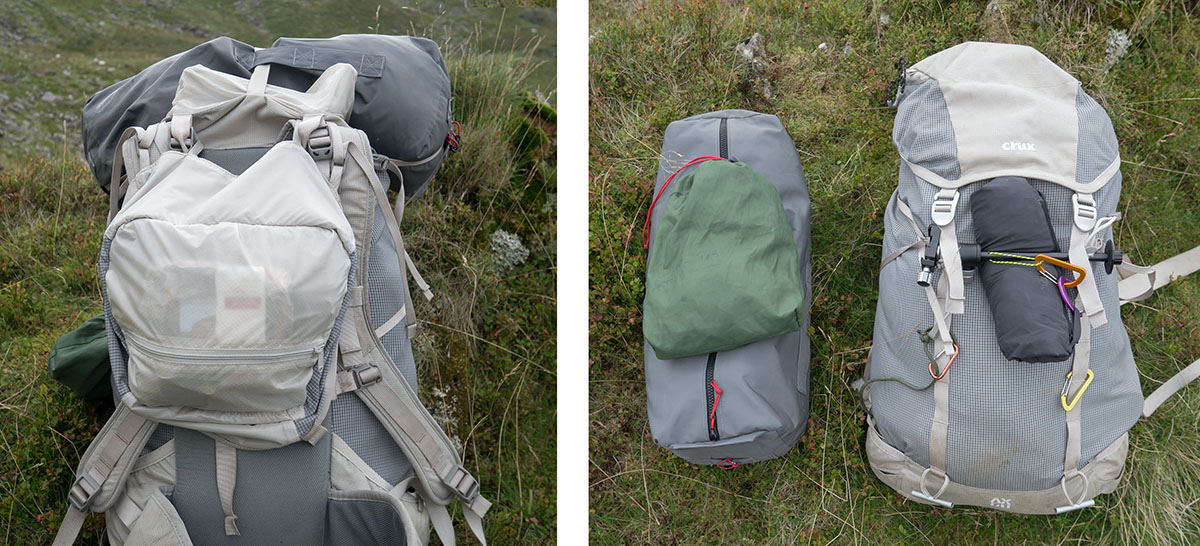 Removing the accessories from the AX50 before looking inside.
Removing the accessories from the AX50 before looking inside.
Under the Floating Lid
The first thing we see is the AX50's sil-nylon extension sleeve with its 3mm cord and stopper. If we open that up we can access the twin titanium stays in their Velcro secured housings (pic #2 below). I use a 100g Osprey UL Pack Liner (size medium, for 50 - 70L packs) to store all the stuff I don't need access to mid-trek.
 A look under the hood of the AX50.
A look under the hood of the AX50.
Looking a little deeper into the bowels of the AX50 we can see the hydration sleeve (which I use to hold a luxury lightweight pair of Teva Mush flip-flops for the return journey for when I can't stand the sight, and others can't stand the smell, of my boots).
 The Crux AX50's hydration sleeve.
The Crux AX50's hydration sleeve.
Back Panel, Shoulder Straps and Daisy Chains
Back on the surface, let's quickly mention what I've missed out. On the front face of the AX50 there are two parallel lines of daisy chain webbing to help attach miscellaneous items to the face of the pack (useful for waterproofs and, for those that take photos, a lightweight tripod). Here we also have two shockcord loop fixings to secure your ice axes.
The AX50 also has small loops on the lid should you want to attach a helmet for example, though we'd attach a helmet lower down via the daisy chain webbing and some shockcord. I often don't carry a helmet, but here I quite like the Warthog's helmet holder housed in its small (3rd) lid pocket.
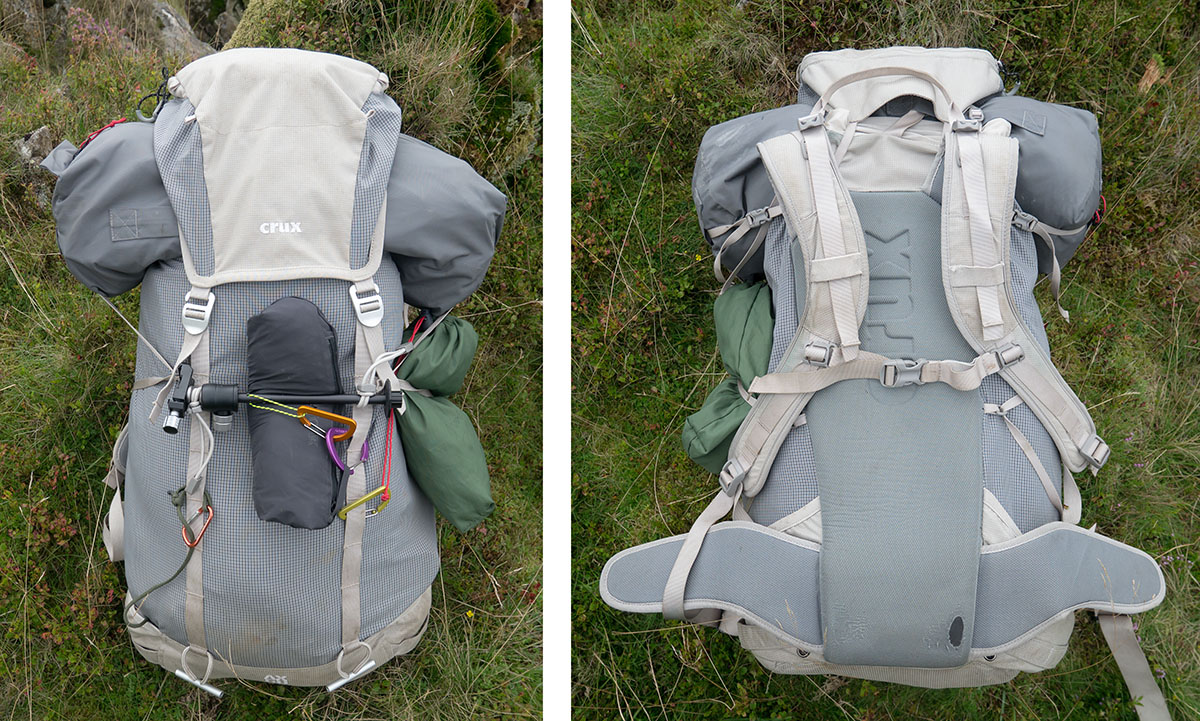 The AX50's back panel and daisy chained webbing down its front face.
The AX50's back panel and daisy chained webbing down its front face.
The back panel is very comfortable and though the shoulder straps don't appear overly padded, their width spreads the load quite nicely. The only times I've felt any discomfort (in the form of an ache) has been at the end of the trek (toward the end of the second week) when the pack is substantially lighter. This is likely just fatigue - after all, humping up and bumping down mountains day in and day out tends to bash the upper shoulder and the muscles just get an ache on after a while.
Any Negatives?
There aren't really any out and out negatives. There's nothing about the AX50 that has particularly annoyed us. There are some shortcomings when measured against Blue Ice's pre-2019 Warthog 40, but then there are also a number of areas where the AX50 out-performs the Warthog.
The Warthog is an absolute tank of a pack. It's wonderfully straight-forward as it's basically an armoured bucket with comfortable straps. In comparison the AX50 can seem a little fiddly. But then all of that additional complexity (mainly around the lid) has a genuinely useful function.
For example, being able to raise the lid substantially is a real bonus and is very handy when over-packing or using something like a Tower or carrying rope. When you accept that the AX50 is designed for climbers who require a narrow profile you appreciate why Crux went for the Z-compression straps (which at first bothered me, but don't anymore).
After spending a good deal of time with the AX50, you learn how to get the most out of it, and when you do, you appreciate just how flexible and functional a pack it is.
The only thing I would change on the AX50 is I'd copy the Warhog's ice axe pick sleeve.
Conclusion & Rating
The 50L Crux AX50's stated non-stripped weight is 1180g. If you add a single standard HIT Tower (135g) you get a ~60L pack weighing 1315g.
The 40L Blue Ice Warthog 40's stated non-stripped weight was 50g lighter at 1130g. If you add two standard HIT Towers (2 x 135 = 270g) you get a ~60L pack weighing 1400g.
The Warthog was a beast of a pack, but the AX50 is well armoured too and at max (60L) capacity the AX50 is 85g lighter. It's also (at full RRP) £40 more expensive (though this is in part due to the older Warthog not having a boost in its price). If compared to the current Blue Ice Warthog 45 (£175) the AX50 is very much on par, at just £4 more (and is far superior).
Now the Blue Ice Warthog (pre-2019) is no longer available the AX50 is its very worthy successor. There was barely anything to choose between them and now we don't have to. The AX50 is a fantastic, durable and flexible pack with a very handy floating lid and everything you need in a climbing pack and none of what you don't. We've been using them for a good number of years now in all seasons. The Warthog King is dead, long live the Crux AX50.
Product Images
Rating (out of 10)
* The value score is derived from two factors:
1) Competitive Market Price (CMP). This represents our judgement of a competitive online price point if we were to stock the item. e.g. if we feel we would need to sell an item at 40% off (i.e. 60% of its full RRP) to be competitive, then our CMP score will be 6/10.
2) Customer Value Price (CVP). We then make an honest appraisal of the maximum price we would be willing to pay for the item (and we're mean). So if we'd pay 80% of its RRP our CVP score would be 8/10.
We then average the two scores to get our final value score, which in our example would be 7/10.
Last Updated: 08/08/24: ("Special Mention" upgraded to top-rated, due to the unavailability of the pre-2019 Blue Ice Warthogs)
